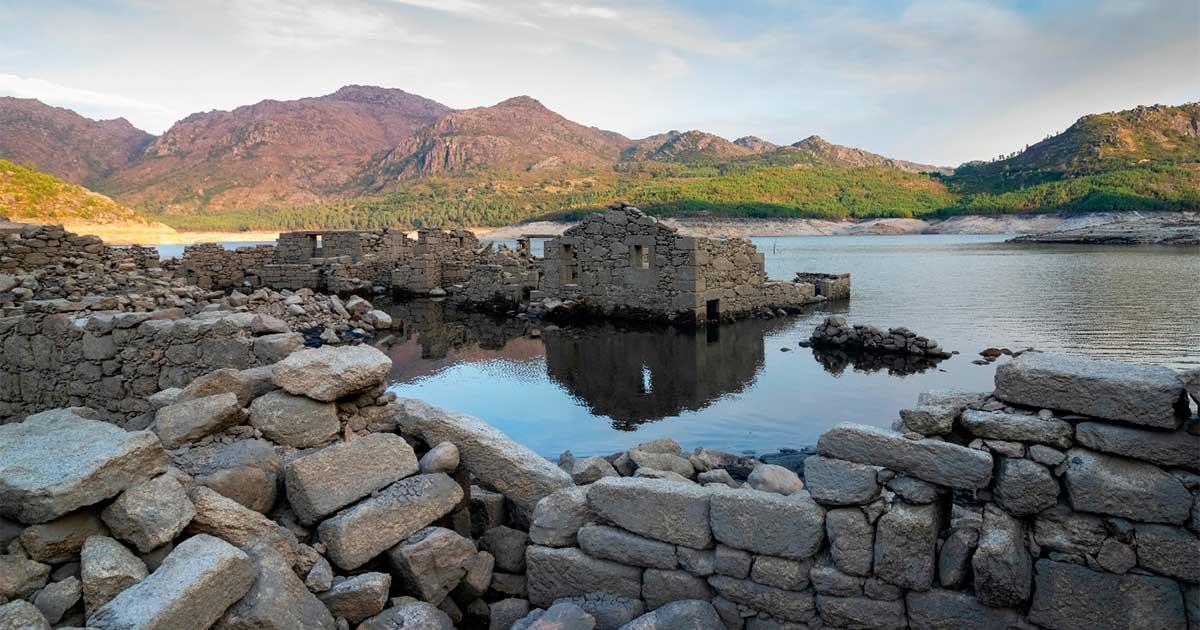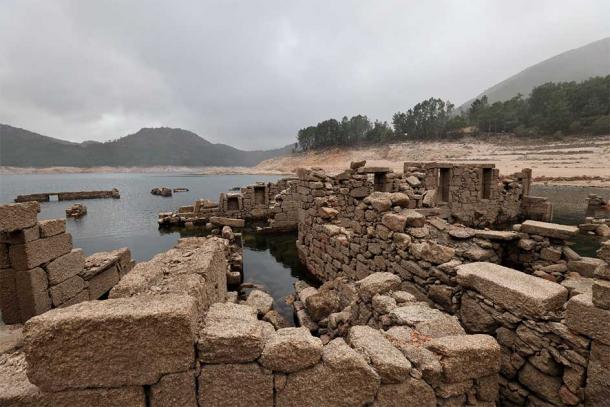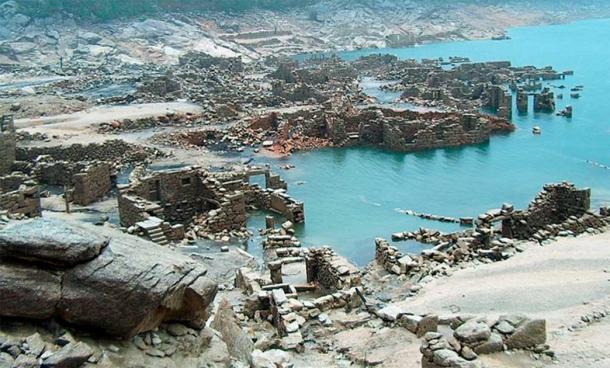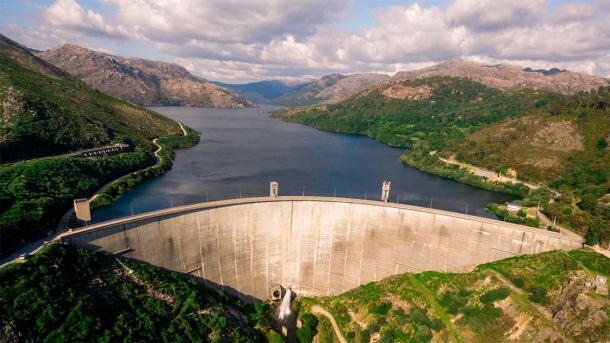
The Submerged Village of Vilarinho da Furna and Its Unique History
Sometimes, the need of modern development necessitates that buildings, villages, or even cities need to be abandoned, demolished, or even submerged in water. It certainly isn’t an easy decision for either the people or the officials, but progress dictates moving forward. This is exactly what the inhabitants of a peaceful Portuguese village had to do: Vilarinho da Furna had a very long history as a remote settlement, but it was nevertheless submerged in water by the Portuguese state. How did such a decision come to pass - and why?

The ruins of Vilarinho da Furna during the dry season, when the former-village becomes exposed Peneda-Geres Portugal. (Frank Fichtmüller/Adobe Stock)
The Long History of Vilarinho da Furna Rests Beneath Dark Water
Sometimes, the need dictates that we abandon fully functioning buildings, items, and even whole settlements. If it is a new building, the impact wouldn’t be all that great. But if it is a peaceful tranquil village with generations of citizens, things become different. And not at all surprisingly, Vilarinho da Furna had a very long history behind it.
Oral traditions that were passed down through generations all state that the village was formed during the settlement of the Germanic Visigoths, around 70 AD. That would make the village almost two millennia old. Whether or not this fact could be confirmed, we don’t know. Not many thorough archaeological excavations were done before the village was submerged, and it could be possible that the earth beneath hides a wealth of unique historical finds.
- Submerged Settlements And Roman Road Discovered Under Venice Waters
- Ancient Submerged Cities: Rethinking Our Ancestry
One of the earliest mentions of the village dates to 1623, when it was included in one of the regional church registries. It was also mentioned by a passing German traveler in the early 18th century, who recorded in detail the way the villagers lived and their well-off status. Thanks to their remote location and the fertile lands all around them, they were relatively wealthy, lacked no food, and had plenty of cattle as well. This German author confirmed this, stating that many villagers back in Germany would be straight out jealous about the well-to-do status of Vilarinho da Furna inhabitants.
Before the submersion, the economy of Vilarinho da Furna was based on cattle. In 1968, the villagers collectively had around 1600 head of cattle, quite a considerable number for the 300 inhabitants. What is more, the villagers were quite unique thanks to several practices that were old and survived only in such remote places.
One was the village council called junta, which is believed to have originated during Visigoth times, when similar customs were recorded. This Junta was devoted to all matters related to the well-being of the village. In a way, it made it a self-sustaining community that solved its own problems - from crime to food production, pastoral duties, and new developments. But all those centuries of rich history were destined to end up submerged.
- Almendres Cromlech: Rare Twin Megalithic Stone Circles of Portugal
- Christopher Columbus: Master Double Agent and Portugal’s 007

Ruins of an old, submerged village with low tide drought in Vilarinho da Furna, Portugal. (Benkeboy/ CC BY-SA 3.0)
A Centuries-Old History, Submerged
Situated in the Portuguese northern district of Braga, the once peaceful village of Vilarinho da Furna was a remote part of the municipality of Terras de Bouro. Even though the village had a supposedly very far-reaching history, it was nevertheless decided by the Portuguese government that it had to be submerged beneath the waters of a newly built reservoir - for the benefit of all citizens of the area. The village had one peculiar and eventually unfortunate aspect to it. It was located at the margins of rivers Homem and Ribeira do Eido. This location was ideal for the creation of an artificial reservoir that would be - presumably - filled by these two rivers.
The government began its plans for the reservoir as early as 1950, conducting needed surveys and test drills. The first steps of the construction of the reservoir were started in 1967. At this time, Vilarinho da Furna had around 300 inhabitants, spread around 80 homes and consisted of 57 families with old roots. These families had to be evicted from their age-old homes to facilitate the filling of the reservoir.
As these things usually go, the government was not entirely fair towards the residents. The problem lay in the indemnity money: the villagers were offered far less than the actual worth of their homesteads.
The land was valued by Companhia Hidroeléctrica do Cavado (Cavado Hydroelectric Company) at just 0.5 escudos (the Portuguese currency of the time) per 1 square meter. For comparison, this was the price of one half of a sardine. When all things were considered, this payment was comical, and far below the standards of the time. But nevertheless, the villagers had no choice in the matter - they had to accept the terms or be submerged together with their homes.

Aerial view of Dam of Vilarinho da Furna on Rio Homem, Portugal. (vitfedotov/Adobe Stock)
A Sad Fate for a Designated Building Site
Another problem for Vilarinho da Furna was its remoteness. It was situated on the southern slopes of Serra Amarela, in the Geres National Park. The area was fertile enough, and protected from freezing winds in winter, with good sun exposure in warmer months. But even so, it was a true village in every sense, situated far from prying eyes and big towns. This meant that good, passable roads were few and far between. And considering that all roads to and from the village were built by the villagers themselves, evacuation was slow and troublesome. The officials failed to construct a proper asphalt path, and thus the villagers were basically left to fend for themselves in order to evacuate their belongings.
In the end, the villagers abandoned what they called their home for so many years. The last inhabitant left in 1971, and in the following year the village was completely submerged beneath the waters. Where once lay a vibrant and busy mountain village was now a vast reservoir with calm blue waters reflecting the sunlight. Today, during the dry season, the water recedes just enough to show the remnants of the village for passing tourists.
In an attempt to preserve the memory of this unique and traditional Portuguese village, the government built a special museum that houses common tools, items, and traditional clothes belonging to some of the villagers. Alas, it did little to remedy the damage that was done to the inhabitants, and it certainly didn’t elevate Vilarinho da Furna from the depths in which it lay.
Alas, there was one problem that the junta of Vilarinho da Furna could not fix, and that was the encroaching arm of modern industry. The modern, 20th century government had little concern for the lengthy history of this village, or the traditional, unique customs that the villagers cultivated for generations. Similarly, they had little regard for their peaceful and idyllic lives. All that mattered to the companies was building the reservoir in the name of progress.
Top image: The village Vilarinho da Furnas inside the national park Peneda-Geres in Portugal. It is only visible at low water levels. Source: Carlos Caridade/Wirestock Creators/Adobe Stock
References
Antunes, M. 2005. A Barragem de Vilarinho da Furna. Arrainos IV.
Calado, D. 1999. Vilarinho da Furna: A Memoria. Escola Superior Gallaecia.
Dias, J. 1983. Vilarinho da Furna: Uma Aldeia Comunitária. Imprensa Nacional Casa da Moeda.
















Comments
The ONLY explanation that makes sense, and it makes perfect sense, is that the construction of the stone complex, came during the Ice Age, when sea levels were MUCH LOWER, probably at least 30k BC, or earlier. This can be estimated based upon how much sea water is estimated to have been ‘locked up’ in the Ice Age glaciation.
I guess they haven’t yet come around to seeing the so-called Neanderthal (aka Atlanteans) as a a fair-haired civilized people, and clearly the most impressive stone-masons who ever walked the Earth. Of course that culture was decimated by the Atlantis event, which caused the Ice Age in sudden fashion, and whose survivors later came under assault by so-called ‘modern man’ (called Semites by the ancient Greeks, the people of the Bible, spawned by the Sumerian/Anunnaki 'gods', who went on take over lands and rewrite history oriented on their own black-headed centricity, ignoring the fair-haired aboriginals/Ice-Age-Survivors who were here when they arrived, at some point after the smoke had cleared.
Nobody gets paid to tell the truth.